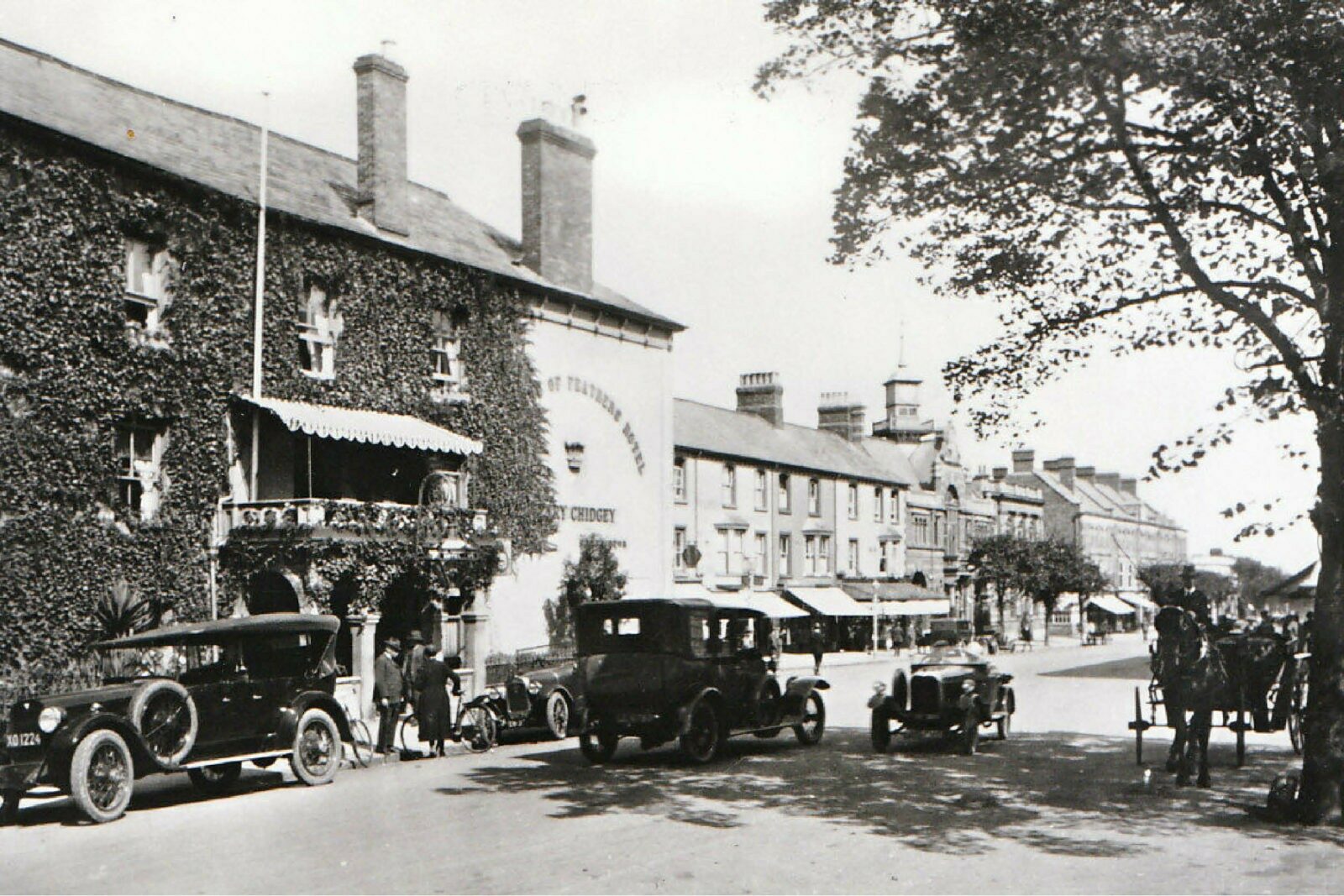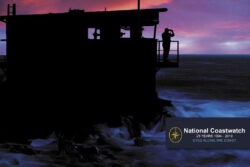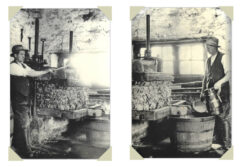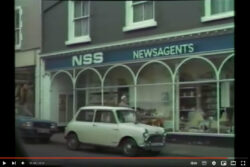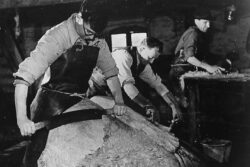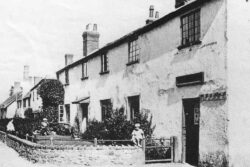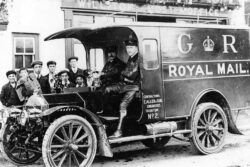If you stand in Wellington Square with your back to Queen Anne and look across the road to the uninspiring row of modern shops that is where the once renowned Plume of Feathers stood. It was built in the 1600’s complete with yard and stables.
In 1686 it belonged to a Deborah Bullocke, a grand-daughter of Edmond Knowles a prosperous merchant of the Civil War period. When her son-in-law Hugh Payne took over from her it was valued at £11. Daniel Defoe, the famous writer stayed here in 1722 and spoke of the rich merchants he saw. In 1756 an advert placed in the Sherborne Mercury read:
‘To be let. The Plume of Feathers Inn or Tavern, Minehead- large and commodious in Market Place- spacious dining room sashed in front, six rooms on a floor, large walled garden,stabling for 150 horses. Enquire Thomas Leigh, Attorney, Dunster.’
In 1760 when Joseph Bancks was Minehead’s MP, George Squires, host of the Plume of Feathers, enjoyed the particularly ‘congenial task of filling three punch bowls.Sir Joseph’s bowl, my Lady’s bowl and another large bowl with a special brew of punch which the assembled company quaffed.’
In Locke’s survey of 1791 the Plume of Feathers was described as ‘the best inn of twelve’ but owing to the fire that swept through parts of Minehead later that year many of the twelve had been destroyed. The Plume of Feathers was spared but in 1794 Basil Mansfield, the then host, decided to re-build parts of it to attract new customers. He placed an advert in a Bristol newspaper:
‘Respectfully acquainting Ladies and Gentlemen that The Plume of Feathers hath lately been refurbished and is now genteely furnished for their reception.And that for their accommodation he hath provided a Commodious Bathing Machine, a Pleasure Yacht and laid in a quantity of the best wine and spirits.’
When Ann Jones was landlady in the 1820s and 30s there was a little rhyme which indicates that the Inn was still being run in the best tradition.
As to the inns the Feathers
ranks first,
According relief to both hunger
and thirst,
And at this Inn public dinners
are dressed,
None set forth better it must
be confessed,
Each Thursday night the gentry
all meet,
A rubber to play, to enjoy
tete-a tete.
The inn was the terminus for horse drawn coaches from Lynmouth, Taunton and Bridgwater. It was a very attractive building and had a verandah at first floor level facing the church where all public announcements were made including election results. It was the foremost hostelry for travellers and the scene of much political banqueting until the 1840’s when it began to deteriorate. Interestingly Dr Clark,a Scotsman and GP, who was Medical Officer at Dunster Hospital, and keen golfer who was instrumental in finding land for a golf course in Minehead advertised a meeting in the Plume of Feathers in 1882 to consider the formation of a club.
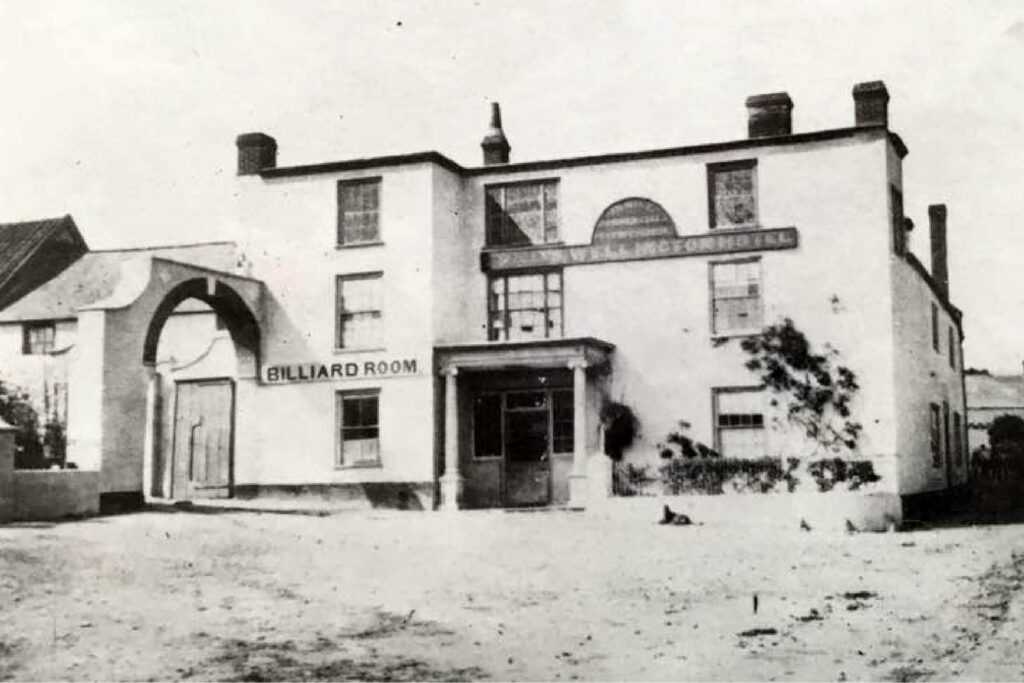
According to Mrs Greensill, the cause of the Inn’s decline was the competition provided by the Duke of Wellington Inn which also acted as a posting inn. However Thomas Warden the Luttrell’s agent claimed that the real reason was that ‘Mrs Greensill was entirely unfit to run the business and with her it would never be profitable’. Fortunately she quit before this was brought home to her.
Sadly the hotel was demolished in 1965. This was voted as Minehead’s greatest planning disaster when Minehead Conservation Society conducted a poll as it was felt that not only was a beautiful heritage building lost to the town but the symmetry of the Market Square was destroyed.
The Duke of Wellington was built in 1820. It was of a different architectural style to the current building. It competed with the Plume of Feathers as a posting house and ran a daily four horse coach service to Taunton via Dunster and left to the blowing of horns. Just 30 years later it was described as ‘an old fashioned house with a thatched roof and an annual rent of £14 thought hardly enough to keep the roof in repair.’
By 1883 it had become a Temperance Coffee Tavern, an initiative of Thomas Ponsford. In 1893 it was demolished to make way for a new purpose built Temperance Hotel and became called The Wellington Hotel.
It provided a reading room especially for the working classes where, besides books, games such as bagatelle were provided. Lectures were given based on religion and temperance! Almost every town in the country had some form of Temperance venue many of imposing architecture.
It became the centre for Friendly Societies. There were two. One was the White Breeches Club with approx. 100 members who wore white breeches on their annual club walk. The other was called Mr Luttrell’s Club because he supported it.
Members of these clubs used to turn out on Oak Apple Day May 29th and cut branches off oak trees and hang them on their houses and wear oak apples.
The hotel was re-licensed in 1902. It became the headquarters of the Polo Club and advertised itself as central for all principal meets of the Devon and Somerset Staghounds and other well-known packs of foxhounds and harriers.
In early 2000s the Boxing Day meet gathered by the Wellie and attracted many spectators. During WW2 American soldiers were based here.
At one time there was a tea garden behind it and whilst an area at the back still exists it is no longer used as such. Since Wetherspoons took it over it has reverted to its original name of The Duke of Wellington.
Compiled by Sally Bainbridge on behalf of Minehead Conservation Society.
Buy the book! Minehead & Beyond
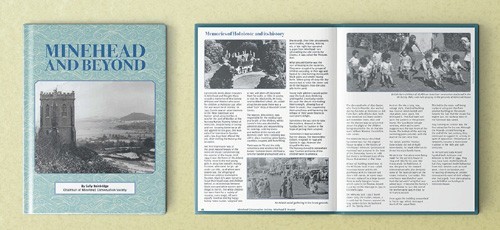
This book is a compilation of articles written for this magazine by Sally Bainbridge on behalf of Minehead Conservation Society. It contains information about the richness of West Somerset’s history; culture; people; heritage; traditions and beautiful and varied landscape. The book costs just Es and all profits go to Minehead Conservation Society.
Available to buy from AR Computing, Park Lane Home Furnishing (in their Park Lane shop), Minehead Tourist Information Centre and Townsend House (Monday am).
Office: Townsend House, Townsend Road, Minehead TA24 5RG (01643 706258) E-mail: [email protected]
